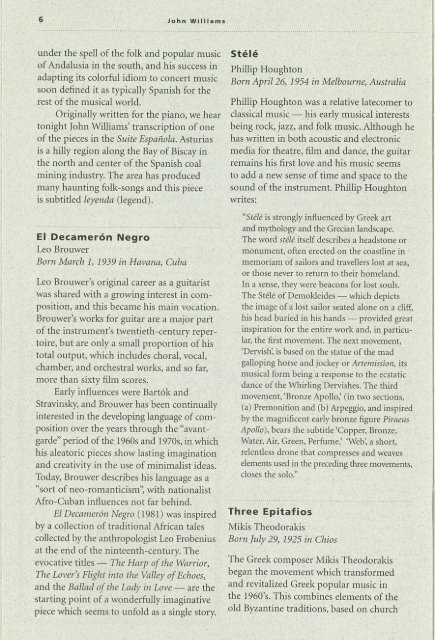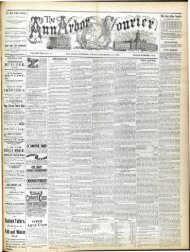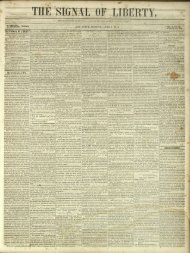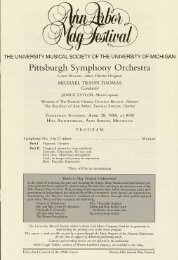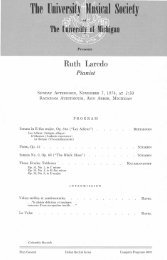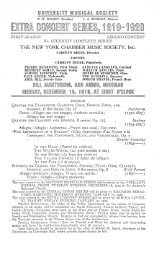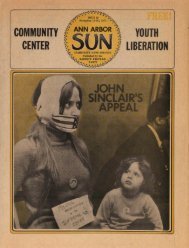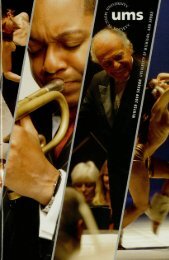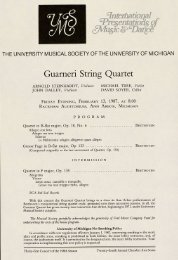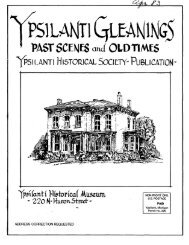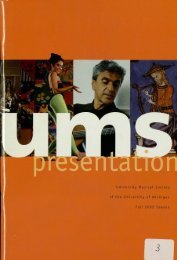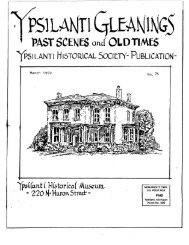University Musical Society - Ann Arbor District Library
University Musical Society - Ann Arbor District Library
University Musical Society - Ann Arbor District Library
You also want an ePaper? Increase the reach of your titles
YUMPU automatically turns print PDFs into web optimized ePapers that Google loves.
John Williams<br />
under the spell of the folk and popular music<br />
of Andalusia in the south, and his success in<br />
adapting its colorful idiom to concert music<br />
soon denned it as typically Spanish for the<br />
rest of the musical world.<br />
Originally written for the piano, we hear<br />
tonight John Williams' transcription of one<br />
of the pieces in the Suite Espafwla. Asturias<br />
is a hilly region along the Bay of Biscay in<br />
the north and center of the Spanish coal<br />
mining industry. The area has produced<br />
many haunting folk-songs and this piece<br />
is subtitled leyenda (legend).<br />
El Decameron Negro<br />
Leo Brouwer<br />
Born March 1, 1939 in Havana, Cuba<br />
Leo Brouwer's original career as a guitarist<br />
was shared with a growing interest in com<br />
position, and this became his main vocation.<br />
Brouwer's works for guitar are a major part<br />
of the instrument's twentieth-century reper<br />
toire, but are only a small proportion of his<br />
total output, which includes choral, vocal,<br />
chamber, and orchestral works, and so far,<br />
more than sixty film scores.<br />
Early influences were Bartok and<br />
Stravinsky, and Brouwer has been continually<br />
interested in the developing language of com<br />
position over the years through the "avant-<br />
garde" period of the 1960s and 1970s, in which<br />
his aleatoric pieces show lasting imagination<br />
and creativity in the use of minimalist ideas.<br />
Today, Brouwer describes his language as a<br />
"sort of neo-romanticism", with nationalist<br />
Afro-Cuban influences not far behind.<br />
El Decameron Negro (1981) was inspired<br />
by a collection of traditional African tales<br />
collected by the anthropologist Leo Frobenius<br />
at the end of the ninteenth-century. The<br />
evocative titles — The Harp of the Warrior,<br />
The Lover's Flight into the Valley of Echoes,<br />
and the Ballad of the Lady in Love — are the<br />
starting point of a wonderfully imaginative<br />
piece which seems to unfold as a single story.<br />
Stele<br />
Phillip Houghton<br />
Born April 26, 1954 in Melbourne, Australia<br />
Phillip Houghton was a relative latecomer to<br />
classical music — his early musical interests<br />
being rock, jazz, and folk music. Although he<br />
has written in both acoustic and electronic<br />
media for theatre, film and dance, the guitar<br />
remains his first love and his music seems<br />
to add a new sense of time and space to the<br />
sound of the instrument. Phillip Houghton<br />
writes:<br />
"Stele is strongly influenced by Greek art<br />
and mythology and the Grecian landscape.<br />
The word stele itself describes a headstone or<br />
monument, often erected on the coastline in<br />
memoriam of sailors and travellers lost at sea,<br />
or those never to return to their homeland.<br />
In a sense, they were beacons for lost souls.<br />
The Stele of Demokleides — which depicts<br />
the image of a lost sailor seated alone on a cliff,<br />
his head buried in his hands — provided great<br />
inspiration for the entire work and, in particu<br />
lar, the first movement. The next movement,<br />
'Dervish', is based on the statue of the mad<br />
galloping horse and jockey or Artemission, its<br />
musical form being a response to the ecstatic<br />
dance of the Whirling Dervishes. The third<br />
movement, 'Bronze Apollo,' (in two sections,<br />
(a) Premonition and (b) Arpeggio, and inspired<br />
by the magnificent early bronze figure Piraeus<br />
Apollo), bears the subtitle 'Copper, Bronze,<br />
Water, Air, Green, Perfume.' 'Web', a short,<br />
relentless drone that compresses and weaves<br />
elements used in the preceding three movements,<br />
closes the solo."<br />
Three Epitafios<br />
Mikis Theodorakis<br />
Born July 29, 1925 in Chios<br />
The Greek composer Mikis Theodorakis<br />
began the movement which transformed<br />
and revitalized Greek popular music in<br />
the 1960's. This combines elements of the<br />
old Byzantine traditions, based on church


